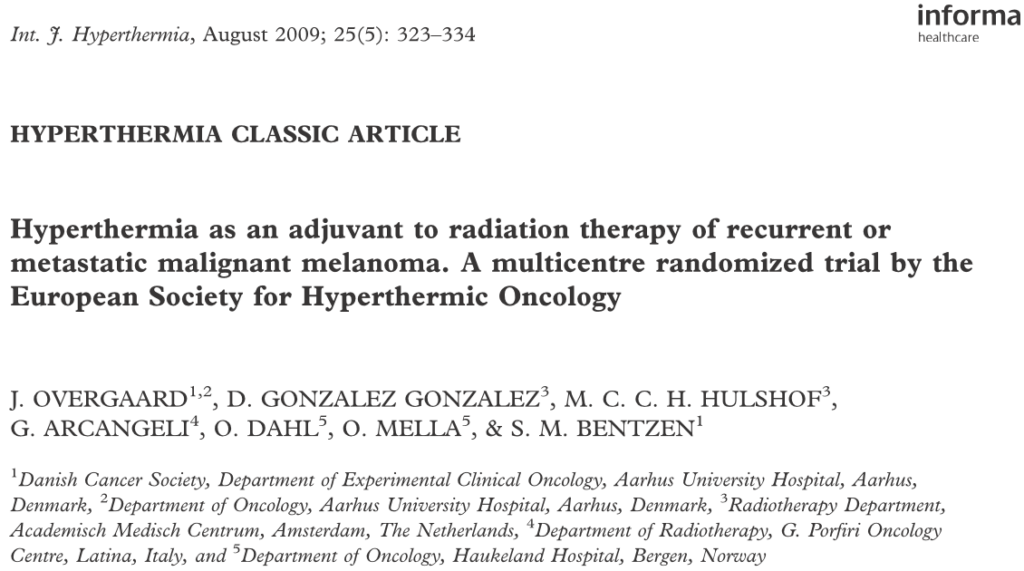Hipertermia jako uzupełnienie radioterapii przy nawrotowym lub przerzutowym czerniaku złośliwym
tytuł oryg.: Hyperthermia as an adjuvant to radiation therapy of recurrent or metastatic malignant melanoma. A multicentre randomized trial by the European Society for Hyperthermic Oncology
Wydawnictwo: International Journal of Hyperthermia
Autor główny: J. Overgaard
Pozostali autorzy: D. Ggonzalez Gonzalez, M. C. C. H. Hulshof, G. Arcangeli, O. Dahl, O. Mella, S. M. Bentzen
Data: 1995-05-23

DOI: 10.1080/02656730903091986
Język publikacji: angielski
Klasa publikacji: Badanie kliniczne
Rodzaj badania: Randomizowane, Wieloośrodkowe, III fazy
Liczba pacjentów: 70
Rodzaj HT: SFHT RF
Rodzaj HT opis: Hipertermia miejscowa powierzchniowa falami radiowymi
Aparatura: BSD-500
Jednostka chorobowa: Czerniak złośliwy
Symbol Jednostki chorobowej: –
Stage: –
Typ skojarzenia HT stosowany w badaniu: RT+HT
Rodzaj CT: –
Abstract. Background: The ESHO protocol 3-85 is a multicentre randomized trial investigating the value of hyperthermia as an adjuvant to radiotherapy in treatment of malignant melanoma.
Methods: A total of 134 metastatic of recurrent malignant melanoma lesions in 70 patients were randomized to receive radiotherapy alone (3 fractions in 8 days) or each fraction followed by hyperthermia (aimed for 43 C for 60 min). Radiation was given with high voltage photons or electrons. Tumours were stratified according to institution and size (above or below 4 cm) and randomly assigned to a total radiation dose of either 24 or 27 Gy to be given with or without hyperthermia. The endpoint was persistent complete response in the treated area. A number of 128 tumours in 68 patients were evaluable, with an observation time between 3 and 72 months. Sixty-five tumours were randomized to radiation alone and 63 to radiationþheat. Sixty received 24 Gy and 68 tumours received 27 Gy, respectively. Size was 4cm in 81 and44 cm in 47 tumours.
Results: Overall the 2-year actuarial local tumour control was 37%. Univariate analysis showed prognostic influence of hyperthermia (rad alone 28% vs. radþheat 46%, p¼0.008) and radiation dose (24 Gy 25% vs. 27 Gy 56%, p¼0.02), but not of tumour size (small 42% vs. large 29%, p¼0.21). A Cox multivariate regression analysis showed the most important prognostic parameters to be: hyperthermia (odds ratio: 1.73 (1.07-2.78), p¼0.02), tumour size (odds ratio: 0.91 (0.85-0.99), p¼0.05) and radiation dose (odds ratio: 1.17 (1.01—1.36), p¼0.05).
Conclusions: Analysis of the heating quality showed a significant relationship between the extent of heating and local tumour response. Addition of heat did not significantly increase the acute or late radiation reactions. The overall 5-year survival rate of the patients was 19%, but 38% in patients if all known disease was controlled, compared to 8% in the patients with persistent active disease.
Potrzebujesz więcej danych o artykule? Skontaktuj się z PTHO droga mailową.